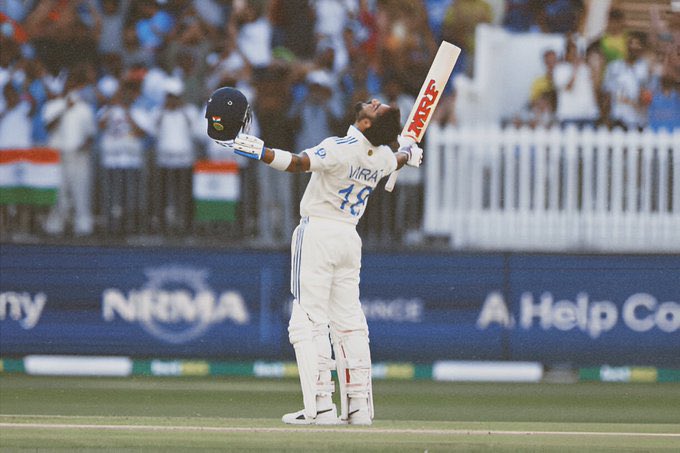
By Bharath Ramaraj
When a top sportsperson hangs up his spiked boots, we delve deeper into his stats and records. We also try to excavate information about some of the athlete’s best performances. The idea behind it is to gauge where does he or she rank among the pantheon of greats.
When Virat Kohli, the biggest brand in the cricketing landscape quit Test cricket, obviously, a lot of time was spent on dissecting his numbers. But there is more to Kohli than just 9,230 runs at an average of 46.85 and 30 hundreds. It is about how legions of fans seemed to live through everything that Kohli did on a cricket field. On the field, he was all heart and aggression, something that resonated with a young India craving for success. No wonder, thousands and thousands of fans were in tears when Kohli decided to walk away from the longest format.
******
The day was August 16, and the year, 2021 – The famous clock at the Lord’s cricket ground was showing the time as 6.37 PM. For most of that day, dark clouds were on the horizon. But just like that, with India on the cusp of a victory, the ground was bathed in sunshine. Somewhere, someone up there seemed to have smiled on Kohli and his men as they registered a memorable win. The essence of that victory was the rallying call made by Kohli, the Indian skipper, before the start of England’s second innings: “If I see someone laughing, then see! For 60 overs, they should feel hell out there.”
For the next few hours, it seemed as if the English batters were indeed wading through ‘hell’ as the four-pronged pace attack of Jasprit Bumrah, Mohammed Siraj, Mohammed Shami and Ishant Sharma bowled with zest and vigour. The resultant outcome was England sliding to a defeat. The picture of a despondent James Anderson putting his head down after losing his wicket and the passionate Indian players’ celebrations further exemplified how Kohli’s aggressive captaincy had become the heartbeat of the side.
Follow Revsportz for latest sports news
All good things though have to come to an end. After the completion of the Test series against South Africa in 2021-22, Kohli stepped down from that role. The fulcrum of the Indian team had left behind a legacy of a side that was almost invincible in home conditions and turned out to be competitive abroad. The lasting impact of Kohli’s captaincy, however, would be that of how he ushered in a fast-bowling culture where India started to believe they could take 20 wickets in S.E.N.A countries.

It is also true that Kohli’s legacy goes well beyond just his captaincy and leadership qualities. At his peak, Kohli was also one of the finest Test batters going around. Between January 1, 2016, to December 31, 2019, Kohli compiled 4208 runs at an impressive average of 66.79 with as many as 16 hundreds to his name. That phase was the annus mirabilis of Kohli’s career: Be it Edgbaston, Perth, Centurion, Wanderers, Vizag or the Wankhede, he led from the front with the willow in hand.
The subplot to that remarkable phase was how he overcame the Anderson threat in England in 2018. He stood almost 50cm outside his crease to negate the late movement. The hip and shoulder were aligned better, and he wasn’t getting squared up while facing outswinging deliveries. With Kohli tightening up the loose nuts and bolts of his batting manual, he went on to accrue 593 runs against the moving ball. Yes, a few catches were dropped off Anderson’s bowling, but in tricky conditions, you need a bit of the rub of the green to go your way.
A few months later, in Perth, Kohli perhaps essayed his finest Test innings in terms of quality of stroke-play and technique. The on-drive that Kohli cracked off Josh Hazlewood told everything that you want to know about this treasured gem. The head, the feet and the legs were perfectly aligned, and right underneath his eyes, he hit the ball on downswing rather than on the follow-through. Just pause the replay and analyse it frame by frame. You’ll observe the bat and pad being tucked very close together. More importantly, under his captaincy, India also won an epoch-making Test series in Australia.
You might also like
🚨 EXCLUSIVE
With Kohli and Sharma stepping away from Test cricket, Indian cricket is staring at a vacuum.
MSK Prasad opens up on the next Test captain and why replacing Kohli at No. 4 will be one of the toughest jobs for selectors—with @gargiraut15 https://t.co/5qMi63XyV6
— RevSportz Global (@RevSportzGlobal) May 13, 2025
Unfortunately, his career path took a downward trend at the dawn of the new decade. During the last five years of his Test career, Kohli aggregated 2028 runs at an average of 30.72; a climb down from the lofty standards that he set at his peak. Eventually, on May 12, 2025, he sent seismic shocks through the cricketing world by quitting that format.
For a moment, you pondered upon how a cricketer who seemed to have the insatiable hunger to score big runs in the longest format lost his appetite to work on his shortcomings: Lack of scoring shots square and behind square on the off-side. But Kohli had clearly made up his mind that it was time to retire.
As a cricket aficionado, you would rather search for an erase button in order to conveniently forget his poor form. Instead, fill the caverns of your brain with how he wore his heart on the sleeve as a captain and uplifted the standards of Indian cricket. And his in-your-face attitude as a batsman. The shirt numbered 18 will continue to bask in its glory long after he bid adieu to Test cricket.
Also Read: With Virat Kohli’s Retirement, the Fab Four Era Nears Its Final Chapter




